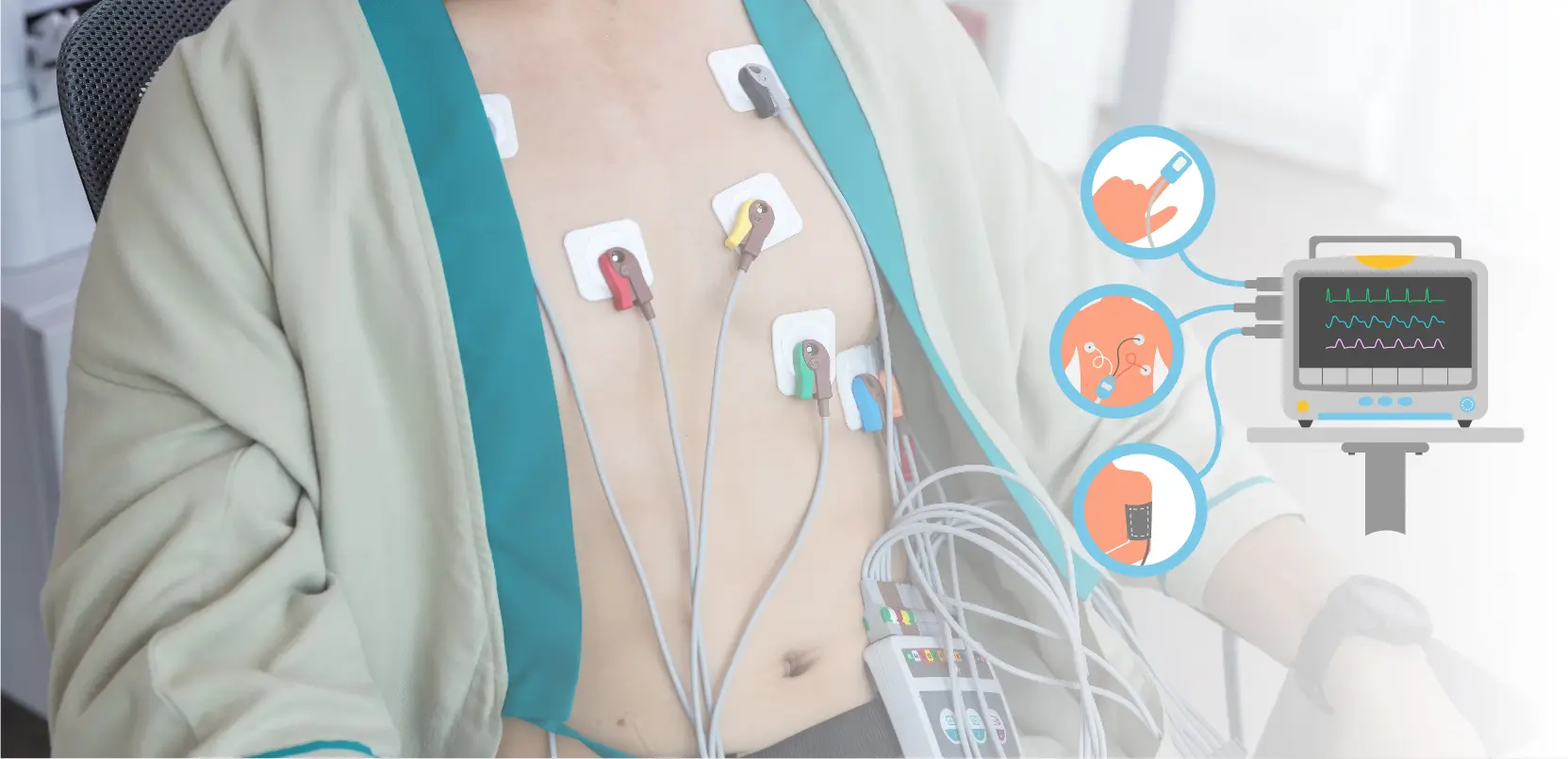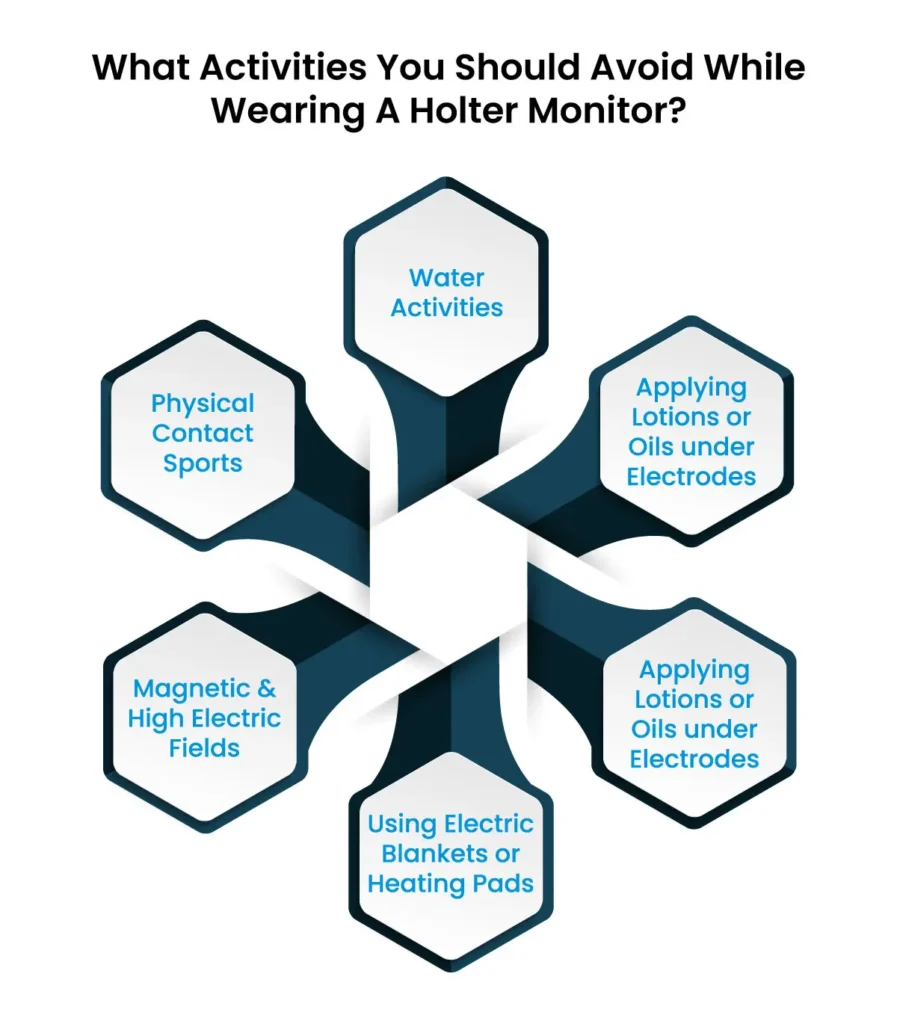

Ever wondered how doctors keep an eye on your heart without keeping you in the hospital all day and night? That’s where a Holter Monitor comes into play. It’s like a tiny spy you wear, tracking your heart’s every move while you go about your daily life.
In this guide, we’ll examine the basics of Holter Monitors—what they really detect, how they work, and why they might be more important than you ever realized.
Whether you’re a heart patient, know someone who is, or are just curious about how modern medicine works, you’re in the right place to learn something new and fascinating.
A Holter monitor is a compact, wearable device that functions as an ambulatory electrocardiogram (ECG). It meticulously tracks the heart’s electrical activity over an extended period, typically 24 to 48 hours, and sometimes even longer.
Unlike the standard ECG, which captures a snapshot of the heart’s activity in a brief moment while you’re at rest, the Holter monitor offers a comprehensive view of your heart’s rhythm and rate as you engage in your daily activities.
This device is ingeniously designed to be small, roughly the size of a smartphone, and is battery-operated, making it easy to carry on with your day-to-day life without significant interruption. It comes equipped with wires and electrodes, which are small, adhesive patches that securely attach to your skin.
Named after Dr. Norman J. Holter, who invented the technology in the 1950s, the Holter monitor has since become an essential tool in the realm of cardiology. It provides invaluable insights into heart conditions that might not be detectable during a short-term ECG test. By monitoring the heart’s activity over an extended period, healthcare providers can identify irregular heartbeats, assess the effectiveness of heart medication, and investigate symptoms like dizziness, palpitations, or fainting spells, which could indicate heart-related issues.
The process is ingeniously simple yet highly effective. The device is attached to the body using wires connected to small electrodes that adhere to the skin, usually around the chest area. These electrodes are the critical components that detect the electrical signals of your heart. As your heart beats, it generates electrical impulses that travel through the body. The Holter monitor’s electrodes pick up these impulses, allowing the device to record your heart’s rhythm and rate continuously.
This device is meticulously designed to detect the subtle and not-so-subtle electrical signals that your heart emits with each beat. As you go about your day, the Holter monitor tirelessly captures data, providing a comprehensive electrocardiograph—a detailed chart of your heart’s rhythm.
This capability is essential for healthcare professionals, especially cardiologists, who rely on the nuanced information the Holter monitor collects to assess the heart’s health. Whether it’s to confirm that your heart is functioning as it should or to unearth potential issues lurking beneath the surface, the monitor’s findings offer invaluable insights that.
It’s particularly adept at detecting and monitoring a range of cardiac issues, providing essential data that can guide treatment and management strategies. Here are some conditions and scenarios where a Holter monitor proves invaluable:
Moreover, the Holter monitor extends its utility beyond diagnosis, assisting in the evaluation of heart treatment plans:
The duration for which a Holter monitor needs to be worn can vary depending on the individual’s symptoms and the specific information your healthcare provider is seeking. Typically, the monitor is worn for 24 to 48 hours.
During this time, it’s crucial to carry on with your regular daily activities as much as possible, as this will provide the most accurate representation of your heart’s activity in your normal environment.
Upon receiving the Holter monitor, you’ll also be given detailed instructions on how to wear the device, how to care for it, and how to record your activities and any symptoms you experience while wearing it. It’s essential to follow these instructions closely to ensure the monitor can collect the data needed for your diagnosis.
Wearing a Holter monitor can be a unique experience, and while it’s designed to be as unobtrusive as possible, some people may find it slightly uncomfortable or inconvenient at times. This discomfort can stem from several factors:
Physical Sensation: The monitor is attached to the body using electrodes that stick to the skin. Some individuals might find the sensation of these electrodes, or the process of wearing them for an extended period, to be a bit unfamiliar or uncomfortable.
Skin Sensitivity: A small number of people may experience skin irritation or sensitivity from the adhesive used on the electrodes. While these reactions are generally mild and resolve after the electrodes are removed, they can cause discomfort during the monitoring period.
Lifestyle Adjustments: The need to keep the monitor dry and attached can necessitate changes to your daily routine, such as avoiding certain types of exercise, showers, or activities that could dislodge the electrodes or damage the monitor. This can be inconvenient and may require some adjustment.
A heart monitor, often used in the form of a Holter monitor, provides a visual representation of the heart’s electrical activity through an ECG (electrocardiogram) trace. This trace appears as a continuous graph made up of peaks and valleys, each illustrating the heart’s rhythm and the timing and strength of its electrical impulses. By analyzing this graph, doctors can gain invaluable insights into the heart’s functioning, identifying any irregularities or signs of conditions that might require further attention.
While wearing a Holter monitor, your daily activities can largely continue as normal, allowing the device to capture an accurate representation of your heart’s activity under typical conditions. However, there are specific activities and precautions you should be aware of to ensure the monitor functions correctly and the data collected is reliable. Here are the key activities to avoid:

Water Activities: Since the Holter monitor and its electrodes are not waterproof, you should avoid swimming, bathing, or showering while wearing the device. Moisture can damage the monitor or cause the electrodes to lose their adhesive quality, disrupting the recording process.
Physical Contact Sports: Activities that involve a high risk of the monitor being knocked or displaced should be avoided. Sports like football, basketball, or soccer could dislodge the electrodes or damage the device, leading to loss of data or inaccurate recordings.
Magnetic and High Electric Fields: It’s advisable to steer clear of environments with strong magnetic fields or high electric fields, such as MRI machines or intense industrial equipment. These fields can interfere with the electrical signals being recorded, potentially skewing the results.
Using Electric Blankets or Heating Pads: Similar to avoiding high electric fields, using electric blankets or heating pads can interfere with the signal the Holter monitor is trying to capture. It’s best to avoid using these while the monitor is attached.
Applying Lotions or Oils under Electrodes: Before the electrodes are attached, ensure your skin is clean and dry without lotions, oils, or other substances that could prevent the electrodes from adhering properly.
Excessive Sweating: While some sweating is normal, particularly during light exercise, extremely sweaty conditions can cause the electrodes to loosen or fall off. Plan your physical activity accordingly, and avoid environments that could lead to excessive sweating.
After completing your Holter monitoring period, which typically lasts 24 to 48 hours, you’ll return to your healthcare provider’s office or the designated facility to have the device removed. Here’s what you can expect in the steps that follow:
Device Removal: A healthcare professional will carefully remove the Holter monitor and the electrodes attached to your skin. This process is straightforward and painless.
Data Analysis: The data collected by the Holter monitor is then downloaded and analyzed. This involves a detailed review of the heart’s electrical activity throughout the monitoring period. Electrophysiologists or cardiologists, who specialize in the heart’s electrical system, may be involved in analyzing the data to identify any irregularities or signs of heart conditions.
Activity Diary Review: If you were asked to keep a diary of your activities and symptoms while wearing the monitor, your healthcare provider would review this alongside the Holter monitor data. Correlating your activities and any symptoms you recorded (such as palpitations, dizziness, or chest pain) with the data can help identify what triggers any irregularities in your heart’s rhythm or other issues.
Follow-Up Appointment: You’ll likely have a follow-up appointment to discuss the Holter monitoring results. During this time, your healthcare provider will explain any abnormalities or findings, answer any questions you may have, and discuss the next steps. These might include additional testing, lifestyle modifications, medication adjustments, or other treatments based on the findings.
Next Steps and Treatment: If the Holter monitor detects any issues, your treatment plan will be tailored to your specific condition. This might involve medication to manage heart rhythm abnormalities, further diagnostic testing for more complex conditions, or lifestyle changes to improve heart health. In some cases, if the Holter monitor does not reveal significant issues but symptoms persist, your healthcare provider might recommend additional monitoring with a different type of device or further cardiac testing.
In wrapping up our comprehensive journey through the world of Holter monitoring, it’s clear that this small but mighty device is a linchpin in modern cardiac care. From its inception in the 1950s to its indispensable role today, the Holter monitor has revolutionized how we understand and manage heart health. By offering a detailed, continuous glimpse into the heart’s electrical activity, it empowers cardiologists to diagnose and treat arrhythmias, palpitations, and other conditions with unprecedented precision.
Talk to an Expert Now